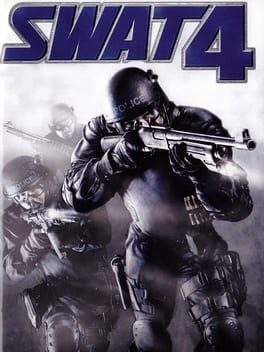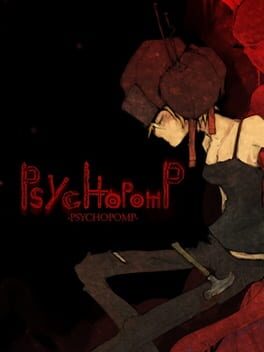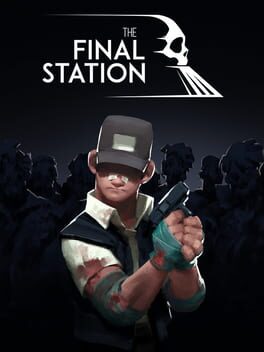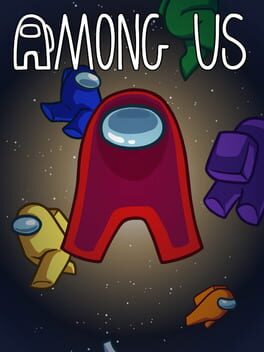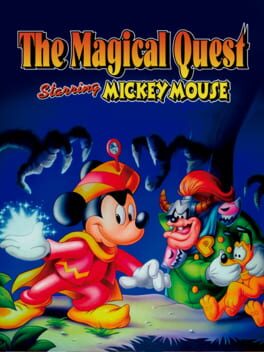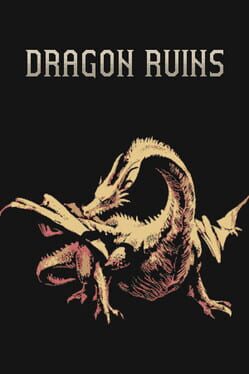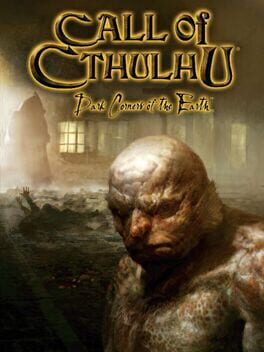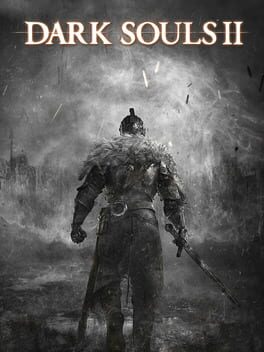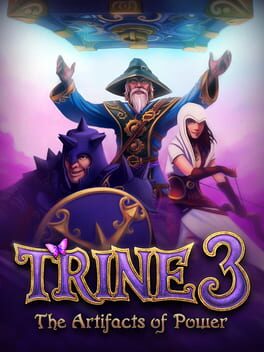Detectivefail
22007 Reviews liked by Detectivefail
AR Games
2011
⏰ In a rush? I gotchu'! ⏰
What Works:
✅ Engaging Warhammer 40,000 Universe: Dive into the gritty, violent world of Space Wolves and Space Marines.
✅ Tactical Gameplay: Similar to X-COM and Mario + Rabbids, offering strategic movement and combat.
✅ Innovative Card System: Unique deck of cards dictates character actions, adding a fresh twist to tactical gameplay.
What Doesn't:
❌ Unbalanced Combat: Inconsistent power distribution among weapons disrupts the strategic flow.
❌ Luck-Dependent Mechanics: Random card draws can hinder tactical planning, making gameplay feel frustrating.
❌ Poor Optimization: Sluggish performance, unintuitive interface, and illegible text on Switch Lite hurt the overall experience.
🚀 Welcome to the Grimdark Universe
The epic that is Warhammer 40,000 constitutes a massive universe filled with grotesque originality and excessive violence, where the Imperium of Man, humanity’s interstellar empire, is protected by genetically altered super soldiers known as Space Marines. The Space Wolves are a breed recognized for their bloody and fierce combat prowess, and they are the focus of this title.
🎮 Tactical Beginnings
In the first few minutes of gameplay, Warhammer 40,000: Space Wolf reminds me of other titles in the genre, such as X-COM or even Mario + Rabbids: Kingdom Battle. The three usable classes in the various campaign missions are capable of typical feats found on this tactical video game genre: moving cautiously to different locations, making short- or long-range attacks, and even assuming support roles to heal other team members. The opposing team, in their turn, will do the same, and thus everything functions like a very advanced game of chess. Unfortunately, it’s a system that lacks not only tactile controls but also has inconsistencies in the power distribution among weapons.
🃏 Cards and Combat
The second aspect that complements and differentiates this title from the existing tide across the galaxy is a deck of cards that dictate the characters’ actions. These are divided into various types such as movement, shields, and weapons, with some being short- or long-range, and others providing direct benefits when equipped. However, this innovative idea also somewhat limits the tactical element found in Warhammer 40,000: Space Wolf. At the beginning of each turn, the highlighted character draws a card from their deck, which is always random. Since the characters’ actions are subject to the available cards, the tactical element loses its momentum, giving way to a feeling of making the best of what’s available.
💸 Free-to-Play Origins
Despite its free-to-play origins on Apple devices, acquiring more cards is relatively easy through the game’s main menu. However, it’s a mechanic that depends on luck, and its randomness is more punishing than one would expect in a paid video game. Yet, this system is not the only area where Warhammer 40,000: Space Wolf starts to show its problems.
🖥️ Interface and Performance Woes
This title is definitely not intuitive with its graphical interface, as players often struggle to get what they want. Another misfortune lies in its slightly poor performance, whether in battles or menus, and as if that weren’t enough, it’s almost out of the question to try the title on a Switch Lite, as some text is completely illegible. But the most incomprehensible aspect is certainly its constant need to be connected to the internet without any justification for it.
❌ Falling Short of Expectations
For a video game with “space wolves” in the title, the expectation was higher than usual. Unfortunately, unbalanced combat, a luck-dependent card system, and a constant need to be connected to the internet, eliminating the portable factor, place Warhammer 40,000: Space Wolf where it deserves: in a space that is not the player’s wallet.
🌟 M I S C 🌟
◻️ 🌳 Linktree for all my stuff.
◻️ ⚠️ Review for FNintendo (RIP) from Feb 26, 2020.
◻️ 🙋♂️ More Reviews by yours truly.
◻️ 🎮 Nintendo Switch Games I’ve played.
◻️ 🧵 Follow me on Threads for updates and more.
◻️ 📜 Review #023
✨ F I N ✨
What Works:
✅ Engaging Warhammer 40,000 Universe: Dive into the gritty, violent world of Space Wolves and Space Marines.
✅ Tactical Gameplay: Similar to X-COM and Mario + Rabbids, offering strategic movement and combat.
✅ Innovative Card System: Unique deck of cards dictates character actions, adding a fresh twist to tactical gameplay.
What Doesn't:
❌ Unbalanced Combat: Inconsistent power distribution among weapons disrupts the strategic flow.
❌ Luck-Dependent Mechanics: Random card draws can hinder tactical planning, making gameplay feel frustrating.
❌ Poor Optimization: Sluggish performance, unintuitive interface, and illegible text on Switch Lite hurt the overall experience.
🚀 Welcome to the Grimdark Universe
The epic that is Warhammer 40,000 constitutes a massive universe filled with grotesque originality and excessive violence, where the Imperium of Man, humanity’s interstellar empire, is protected by genetically altered super soldiers known as Space Marines. The Space Wolves are a breed recognized for their bloody and fierce combat prowess, and they are the focus of this title.
🎮 Tactical Beginnings
In the first few minutes of gameplay, Warhammer 40,000: Space Wolf reminds me of other titles in the genre, such as X-COM or even Mario + Rabbids: Kingdom Battle. The three usable classes in the various campaign missions are capable of typical feats found on this tactical video game genre: moving cautiously to different locations, making short- or long-range attacks, and even assuming support roles to heal other team members. The opposing team, in their turn, will do the same, and thus everything functions like a very advanced game of chess. Unfortunately, it’s a system that lacks not only tactile controls but also has inconsistencies in the power distribution among weapons.
🃏 Cards and Combat
The second aspect that complements and differentiates this title from the existing tide across the galaxy is a deck of cards that dictate the characters’ actions. These are divided into various types such as movement, shields, and weapons, with some being short- or long-range, and others providing direct benefits when equipped. However, this innovative idea also somewhat limits the tactical element found in Warhammer 40,000: Space Wolf. At the beginning of each turn, the highlighted character draws a card from their deck, which is always random. Since the characters’ actions are subject to the available cards, the tactical element loses its momentum, giving way to a feeling of making the best of what’s available.
💸 Free-to-Play Origins
Despite its free-to-play origins on Apple devices, acquiring more cards is relatively easy through the game’s main menu. However, it’s a mechanic that depends on luck, and its randomness is more punishing than one would expect in a paid video game. Yet, this system is not the only area where Warhammer 40,000: Space Wolf starts to show its problems.
🖥️ Interface and Performance Woes
This title is definitely not intuitive with its graphical interface, as players often struggle to get what they want. Another misfortune lies in its slightly poor performance, whether in battles or menus, and as if that weren’t enough, it’s almost out of the question to try the title on a Switch Lite, as some text is completely illegible. But the most incomprehensible aspect is certainly its constant need to be connected to the internet without any justification for it.
❌ Falling Short of Expectations
For a video game with “space wolves” in the title, the expectation was higher than usual. Unfortunately, unbalanced combat, a luck-dependent card system, and a constant need to be connected to the internet, eliminating the portable factor, place Warhammer 40,000: Space Wolf where it deserves: in a space that is not the player’s wallet.
🌟 M I S C 🌟
◻️ 🌳 Linktree for all my stuff.
◻️ ⚠️ Review for FNintendo (RIP) from Feb 26, 2020.
◻️ 🙋♂️ More Reviews by yours truly.
◻️ 🎮 Nintendo Switch Games I’ve played.
◻️ 🧵 Follow me on Threads for updates and more.
◻️ 📜 Review #023
✨ F I N ✨
TwinBee
1986
A short and cute shoot em up (or cute em up, if you'd like), it's a bit slow to be as frenetic and enjoyable as others in the genre, but it's always fun to visit this era of gaming. It's about the high scores, cause the game resets itself after certain level, so I won't revisit this one. Still fun to test for a while, but if you have better options, go to them.
The Saboteur
2009
The Saboteur is the swansong of the incredibly talented Pandemic Studios before being shuttered by the always accommodating and fun EA. Most notable for the original Star Wars: Battlefront games, as well as Destroy All Humans 1 & 2 and Mercenaries 1 & 2, The Saboteur definitely feels like Pandemic playing to their strengths once again, which is fitting as both a standalone game from them as well as their swansong.
The Saboteur definitely fits nicely into that eighth-gen open-world sandbox framework that was popular post-GTA 4, a la Sleeping Dogs and Assassin's Creed 2. The latter title is also a fitting comparison given that The Saboteur seems to borrow a lot of its ideas and their implementation from the Assassin's Creed games, down to the social stealth elements and parkour.
However, despite being an inspired approach to a sandbox game from a clearly talented team, overall The Saboteur can be best summed up as being "more than the sum of its parts". The art direction, voice acting, soundtrack, and gameplay concepts are great. However, the implementation of those individual gameplay concepts is where it stops short of being a cohesive package.
To elaborate, each of its individual gameplay elements can be best described as being "okay". None of them, from driving, shooting, parkour, melee to especially its stealth systems feel satisfying in isolation with too many jarring little details stopping them from being seamless and fun to play around with.
To use an example, stealth involves your usual sneaking but on top of that, you can wear disguises to try and enter enemy bases. This takes the form of a little cone of suspicion that gets wider depending on what actions you're doing (sprinting, climbing, etc), so you generally have to play it cool at all times. That would be fine if not for the fact that if and when you get caught and your suspicion meter fills, the knockout or stealth attack prompts don't always appear, and when they do, you only have a split second to hit them before the alarm is blown. From that point, you can either go through the tedium of escaping or shooting your way out or just reload the last checkpoint.
It gets to a point where you're honestly better just gunning it straight for the objective and not even bothering with stealth or enemies.
Each facet of The Saboteur's gameplay is like this, with hinky little details that impede the game from being fun. However, there definitely are times, particularly during the big story missions when each of these individually okay aspects come together to make things cinematic and fun, especially with the soundtrack in the background.
Again, the stuff that's great is great. The art direction in particular, with the world being black and white with specific splotches of color in Nazi-occupied areas and then becoming fully color once you've liberated them. The story is also a decent pulpy WW2 spy thriller adventure propped up by some great voice acting, especially from the great Robin Atkin Downes as lead Sean Devlin.
Despite the gameplay being largely disappointing overall, really The Saboteur is still worth playing for some good eighth-gen fun and adventure by a talented team that was clearly too good for EA and didn't get the respect they deserved, as per usual.
6/10
The Saboteur definitely fits nicely into that eighth-gen open-world sandbox framework that was popular post-GTA 4, a la Sleeping Dogs and Assassin's Creed 2. The latter title is also a fitting comparison given that The Saboteur seems to borrow a lot of its ideas and their implementation from the Assassin's Creed games, down to the social stealth elements and parkour.
However, despite being an inspired approach to a sandbox game from a clearly talented team, overall The Saboteur can be best summed up as being "more than the sum of its parts". The art direction, voice acting, soundtrack, and gameplay concepts are great. However, the implementation of those individual gameplay concepts is where it stops short of being a cohesive package.
To elaborate, each of its individual gameplay elements can be best described as being "okay". None of them, from driving, shooting, parkour, melee to especially its stealth systems feel satisfying in isolation with too many jarring little details stopping them from being seamless and fun to play around with.
To use an example, stealth involves your usual sneaking but on top of that, you can wear disguises to try and enter enemy bases. This takes the form of a little cone of suspicion that gets wider depending on what actions you're doing (sprinting, climbing, etc), so you generally have to play it cool at all times. That would be fine if not for the fact that if and when you get caught and your suspicion meter fills, the knockout or stealth attack prompts don't always appear, and when they do, you only have a split second to hit them before the alarm is blown. From that point, you can either go through the tedium of escaping or shooting your way out or just reload the last checkpoint.
It gets to a point where you're honestly better just gunning it straight for the objective and not even bothering with stealth or enemies.
Each facet of The Saboteur's gameplay is like this, with hinky little details that impede the game from being fun. However, there definitely are times, particularly during the big story missions when each of these individually okay aspects come together to make things cinematic and fun, especially with the soundtrack in the background.
Again, the stuff that's great is great. The art direction in particular, with the world being black and white with specific splotches of color in Nazi-occupied areas and then becoming fully color once you've liberated them. The story is also a decent pulpy WW2 spy thriller adventure propped up by some great voice acting, especially from the great Robin Atkin Downes as lead Sean Devlin.
Despite the gameplay being largely disappointing overall, really The Saboteur is still worth playing for some good eighth-gen fun and adventure by a talented team that was clearly too good for EA and didn't get the respect they deserved, as per usual.
6/10
SWAT 4
2005
SWAT 4: One of your objectives is always “Bring order to chaos.” 429 Adam, this is central B.C.C.
I am biased towards SWAT 4 because I've played this game off-and-on for over a decade, now. I have many memories that'll simply always have me cherishing this game. GET DOWN ON THE GROUND, NOW! However, there's simply not denying this game is not without issues. In fact, they kinda run rampant.
You will die without any semblance of a fair fight, one shot to the head as soon as you peer around a corner by the world's best gunslingers. Your team's flashbang may do nothing to someone in the room (if they even listen and stack up on the door the first time you tell them to), so when they breach, they all run in and are gunned down by the same perp in a heartbeat. Reload checkpoint? Hilarious! SWAT 4 doesn't have any. If your team goes down and you want the backup/those points? You're starting the level over.
The game will simply throw away several levels' worth of progress on you and give you a fat middle finger about it. If you REALLY want to be sure it saves, you have to beat a level, close the game entirely, then reboot it up. Quitting to the main menu didn't save me. Unauthorized use of force: -5 points. Since the game did hard crash on me in only a few hours of playtime AND I got a bug where I got stuck during a level's intro and had to restart the whole application, this is wildly frustrating to see. Multiple levels gone, multiple times.
If you get shot in the leg, enjoy limping slow as shit for the rest of the level. Hope you're nearly done or are extremely patient, otherwise that's a restart.
But this game has fantastic highlights, too. Despite what a briefing may tell you (and this game gives you a comical amount of info before a level, like 9-1-1 calls you won't care about), you truly do not know what'll happen once you enter that first door. If you've played SWAT 4, all I need to say is “The Fairfax Residence” (and that's the second level!). Basically, expect curveballs galore. There's a fantastic use of sound in this game, the music choices are impeccable as you explore suburban nightmares. ZIP 'EM UP! Successfully clearing a room, you and your squad shouting at civvies and perps to get those hands up, dropping those who refuse and calling it all in, room-by-room? It can feel nice.
There's a mod called “SWAT 4 Elite Force” that adds many features to the game that should have been there. I believe it also fixed some issues. I haven't tried it but I think I'd like to some day.
I recommend SWAT 4. I think Ready or Not is basically the same game, though, if you're looking for something newer. That's on my list.
Don't tell your momma...
...she ain't got to know.
I am biased towards SWAT 4 because I've played this game off-and-on for over a decade, now. I have many memories that'll simply always have me cherishing this game. GET DOWN ON THE GROUND, NOW! However, there's simply not denying this game is not without issues. In fact, they kinda run rampant.
You will die without any semblance of a fair fight, one shot to the head as soon as you peer around a corner by the world's best gunslingers. Your team's flashbang may do nothing to someone in the room (if they even listen and stack up on the door the first time you tell them to), so when they breach, they all run in and are gunned down by the same perp in a heartbeat. Reload checkpoint? Hilarious! SWAT 4 doesn't have any. If your team goes down and you want the backup/those points? You're starting the level over.
The game will simply throw away several levels' worth of progress on you and give you a fat middle finger about it. If you REALLY want to be sure it saves, you have to beat a level, close the game entirely, then reboot it up. Quitting to the main menu didn't save me. Unauthorized use of force: -5 points. Since the game did hard crash on me in only a few hours of playtime AND I got a bug where I got stuck during a level's intro and had to restart the whole application, this is wildly frustrating to see. Multiple levels gone, multiple times.
If you get shot in the leg, enjoy limping slow as shit for the rest of the level. Hope you're nearly done or are extremely patient, otherwise that's a restart.
But this game has fantastic highlights, too. Despite what a briefing may tell you (and this game gives you a comical amount of info before a level, like 9-1-1 calls you won't care about), you truly do not know what'll happen once you enter that first door. If you've played SWAT 4, all I need to say is “The Fairfax Residence” (and that's the second level!). Basically, expect curveballs galore. There's a fantastic use of sound in this game, the music choices are impeccable as you explore suburban nightmares. ZIP 'EM UP! Successfully clearing a room, you and your squad shouting at civvies and perps to get those hands up, dropping those who refuse and calling it all in, room-by-room? It can feel nice.
There's a mod called “SWAT 4 Elite Force” that adds many features to the game that should have been there. I believe it also fixed some issues. I haven't tried it but I think I'd like to some day.
I recommend SWAT 4. I think Ready or Not is basically the same game, though, if you're looking for something newer. That's on my list.
Don't tell your momma...
...she ain't got to know.
Psychopomp
2024
The Final Station
2016
Major studios can never beat indie developers in terms of creativity ang genre-blending. This game is one of the many proofs.
-Game divides into two parts, so it has two types of gameplay. One is a train management simulator; you will have to tend to your passengers, check the battery, and make sure the engine doesn't heat up. This part is quiet easy, for most of it. In my playthrough nothing happened to the train but some passengers did die... The other part is scavenging. After each train management part of the game; you reach an station which is mostly likely destroyed by the virus. You will have to look for supplies and most importantly a code to unlock the fuel supplies. This part can be a bit hard because of the small amount of ammos and how much enemies can damage you. Unfortunately the game is too long and drags too much, and the gameplay (neither of the parts) can't hold up.
-The story should be obvious by now; you are the locomotive driver of one the last trains left in the world. You are the last chance of humanity since you will have to deliver vital components of a "device" that can save the world. There is also the personal side of the story. The protagonist is looking and trying to contact his family, and the last chapter of the game is solely about finding them. The ending and the atmosphere of the game drowns you into the world of it.
-From the visual aspect the game is good but nothing more. Some of the environments which is shown in the background while on the train, are beautiful; but majority of the game you see very simple but effective art design.
-The music is also simple compared to major titles; but it can get the job done. Although I would have preferred more usage of music in the game since there is no dialogue.
As I said, the idea of mixing an apocalyptic shooter and train management was something I never though I would see. But it was executed very well and it can give you a good couple of hours of entertainment.
-Game divides into two parts, so it has two types of gameplay. One is a train management simulator; you will have to tend to your passengers, check the battery, and make sure the engine doesn't heat up. This part is quiet easy, for most of it. In my playthrough nothing happened to the train but some passengers did die... The other part is scavenging. After each train management part of the game; you reach an station which is mostly likely destroyed by the virus. You will have to look for supplies and most importantly a code to unlock the fuel supplies. This part can be a bit hard because of the small amount of ammos and how much enemies can damage you. Unfortunately the game is too long and drags too much, and the gameplay (neither of the parts) can't hold up.
-The story should be obvious by now; you are the locomotive driver of one the last trains left in the world. You are the last chance of humanity since you will have to deliver vital components of a "device" that can save the world. There is also the personal side of the story. The protagonist is looking and trying to contact his family, and the last chapter of the game is solely about finding them. The ending and the atmosphere of the game drowns you into the world of it.
-From the visual aspect the game is good but nothing more. Some of the environments which is shown in the background while on the train, are beautiful; but majority of the game you see very simple but effective art design.
-The music is also simple compared to major titles; but it can get the job done. Although I would have preferred more usage of music in the game since there is no dialogue.
As I said, the idea of mixing an apocalyptic shooter and train management was something I never though I would see. But it was executed very well and it can give you a good couple of hours of entertainment.
I remember when I was introduced to Final Smash as a mechanic and thinking it was dumb. Then I played it and it was great. I enjoyed this one a lot, and probably is one that I've sink most time in, so I can't help but rank it based on the memories I've made. For nearly a decade, every one of my birthdays had at least some rounds of this game, and for that, I'll always love it.
Among Us
2018
As a 90's kid, I played A LOT the Disney's Magical Quest trilogy. My favorite was the one with Donald and this one, the first one, was the one I played the least. Not only because there was no extra character (like Minnie or Donald) and no cooperative gameplay, but also because I'd say it was far way more difficult than the other two sequels. I used to die more often and was only able to beat the game playing with my older brother. Years later I managed to beat the game myself but I've always preferred the other instalments in this trilogy.
That being said, I love this game: the story, the different outfits with different powers Mickey can get (best outfit? Magician is great but the mountain-climbing gear was the best for me!). The enemies were fun, the music was quite memorable and I like the fact that you have to save your dog Pluto from Emperor Pete! (there should be a subgenre in games and movies about this, something like "hero must defeat bad guy to save his/her dog"). Writing this makes me feel like playing it again. It's really a 90's classic and it will always have a place in my heart.
That being said, I love this game: the story, the different outfits with different powers Mickey can get (best outfit? Magician is great but the mountain-climbing gear was the best for me!). The enemies were fun, the music was quite memorable and I like the fact that you have to save your dog Pluto from Emperor Pete! (there should be a subgenre in games and movies about this, something like "hero must defeat bad guy to save his/her dog"). Writing this makes me feel like playing it again. It's really a 90's classic and it will always have a place in my heart.
Dragon Ruins
2024
Essentially, a dungeon crawler in which you... errr... crawl through a... dungeon...?
Minimalist to a fault, I applaud the devs for sticking to their guns; Dragon Ruins is exactly what you read on the label: you enter, you explore, you fight and so on and so forth. You can choose a 4-people party and try mix and matching, but essentially that's the game. You don't even battle, since it's all done automatically.
I said minimalist to a fault, since the game doesn't have anything outside the bare minimum, but what else do you need? Stripping all the unnecessary fat makes the game exactly what it is, a quick and effective bite-sized dungeon crawler. The fruits of love are there: the joy of escaping with half the party down, the heart breaking decision to retreat before opening another door, exploring a section and finding a secret. It's the three Rs: retrieval, revenge, rescue. Like any other proper game in the genre, where visuals could be lacking (extraordinary pixel art though) imagination runs rampart.
I would've loved more of it, but what I played showed promise and care. Looking forward to more.
Minimalist to a fault, I applaud the devs for sticking to their guns; Dragon Ruins is exactly what you read on the label: you enter, you explore, you fight and so on and so forth. You can choose a 4-people party and try mix and matching, but essentially that's the game. You don't even battle, since it's all done automatically.
I said minimalist to a fault, since the game doesn't have anything outside the bare minimum, but what else do you need? Stripping all the unnecessary fat makes the game exactly what it is, a quick and effective bite-sized dungeon crawler. The fruits of love are there: the joy of escaping with half the party down, the heart breaking decision to retreat before opening another door, exploring a section and finding a secret. It's the three Rs: retrieval, revenge, rescue. Like any other proper game in the genre, where visuals could be lacking (extraordinary pixel art though) imagination runs rampart.
I would've loved more of it, but what I played showed promise and care. Looking forward to more.
I guess it's an alright stealth game, and the depiction of Innsmouth is still better than the horrendous Stuart Gordon movie (Dagon). But the atrocious writing ruins any attempts at horror and immersion here.
Every character and their every line of dialogue is a cliche. Every cutscenes is a borefest. The writing neither imitates Lovecraft's style nor even the way people talked at the beginning of the 20th century. And having stuff like "Gilman Hotel" with its owner Charlie Gilman is like something out of a parody. Oh yeah, we fish-people like to have fish-related names so you could see there's something fishy about us. In addition, the game expects you to read logs, which are just as horrendously written. If this game was a book, nobody would've ever read it. I gave up at the point where Zadok was retelling me the premise of 'The Shadow over Innsmouth', at which point I questioned what I was even doing, listening to this bastardized version of a great book instead of just revisiting the actual book.
I'm not gonna address the gameplay much, which seems fine for a stealth game, but I'm not usually into stealth games unless they do something unique and cool like Tenchu or MGS. But there is this dissonance between the story and the gameplay that manifests in different ways. For example, there's a million of locked doors. And I like to check every corner of every level for the fear of missing something (especially in adventure games), and the phrase "it won't budge" has become a major annoyance in the little time I played this. Interacting with objects just to hear the character say obvious things like "it's a stove" is also making the game look silly, thus reducing the horror. And what's up with that prologue where they send you into a house full of armed cultists without a gun? It just doesn't make sense and takes you out of the world. I felt the same way with all the rude Innsmouthians that straight up insult you without the game letting you retaliate. I'd much rather they just grunted and walked away, which I think would only add to the sense alienation and suspicion.
I think, while CoC: DCotE (what an acronym!) is a better game, Darkness Within, which I reviewed recently, is an infinitely better Lovecraftian horror adventure. I'd rather play that game with a guide than spend any time on this without one. Plus I've heard it becomes very action-y in the second half and that the action here is not very good.
Every character and their every line of dialogue is a cliche. Every cutscenes is a borefest. The writing neither imitates Lovecraft's style nor even the way people talked at the beginning of the 20th century. And having stuff like "Gilman Hotel" with its owner Charlie Gilman is like something out of a parody. Oh yeah, we fish-people like to have fish-related names so you could see there's something fishy about us. In addition, the game expects you to read logs, which are just as horrendously written. If this game was a book, nobody would've ever read it. I gave up at the point where Zadok was retelling me the premise of 'The Shadow over Innsmouth', at which point I questioned what I was even doing, listening to this bastardized version of a great book instead of just revisiting the actual book.
I'm not gonna address the gameplay much, which seems fine for a stealth game, but I'm not usually into stealth games unless they do something unique and cool like Tenchu or MGS. But there is this dissonance between the story and the gameplay that manifests in different ways. For example, there's a million of locked doors. And I like to check every corner of every level for the fear of missing something (especially in adventure games), and the phrase "it won't budge" has become a major annoyance in the little time I played this. Interacting with objects just to hear the character say obvious things like "it's a stove" is also making the game look silly, thus reducing the horror. And what's up with that prologue where they send you into a house full of armed cultists without a gun? It just doesn't make sense and takes you out of the world. I felt the same way with all the rude Innsmouthians that straight up insult you without the game letting you retaliate. I'd much rather they just grunted and walked away, which I think would only add to the sense alienation and suspicion.
I think, while CoC: DCotE (what an acronym!) is a better game, Darkness Within, which I reviewed recently, is an infinitely better Lovecraftian horror adventure. I'd rather play that game with a guide than spend any time on this without one. Plus I've heard it becomes very action-y in the second half and that the action here is not very good.
Dark Souls II
2014
The infamous ugly duckling of the Souls family, but that doesnt stop me for even a moment from admiring some of Dark Souls 2 finer qualities. The drowsy, somber atmosphere, like Im walking through a series of half-dreamt sleepless nights. The incredibly forward-facing innovation with covenants and bonfire ascetics. The almost compulsive fixation on secrets, sometimes to the extent of hiding unremarkable things in obscure corners of the map. Theres a curious quiet nature to this game that sort of sticks in your mind.
I continue to hold that this maybe should have been a Kings Field game, or its own standalone game. Dragon Souls or something, whatever it would have to be called to remove the burden of expectations as a sequel - because I think the only real problem with Dark Souls 2 is that it had to be the second Dark Souls. It had to add context, answer questions, share themes and associations. I mean just picture it: this would have been a kickass Kings Field 5.
I continue to hold that this maybe should have been a Kings Field game, or its own standalone game. Dragon Souls or something, whatever it would have to be called to remove the burden of expectations as a sequel - because I think the only real problem with Dark Souls 2 is that it had to be the second Dark Souls. It had to add context, answer questions, share themes and associations. I mean just picture it: this would have been a kickass Kings Field 5.
Trine 2 not only continues the enchanting journey of its predecessor but also expands and enhances the experience in many delightful ways. Maintaining the series' signature charm, this sequel introduces several exciting features that elevate the gameplay to new heights.
Returning to the adventure are Amadeus the Wizard, Pontius the Knight, and Zoya the Thief, each bringing new perks and abilities to the table. Amadeus can now conjure more types of objects, such as planks and floating platforms; Pontius gains combat enhancements like a powerful charge attack and the ability to reflect projectiles with his shield and Zoya enhances her agility with multi-arrow shots and a more versatile grappling hook, which allows her to traverse the environment with greater ease and precision.
The narrative in Trine 2 continues the fairy tale-like storytelling of the first game. Amadeus, Pontius, and Zoya are called upon once again to save their kingdom from a new magical threat.
The game's visuals have been significantly upgraded. The detailed backgrounds, enhanced lighting, and smooth animations create an immersive and breathtaking world that feels alive and full of wonder.
The soundtrack of Trine 2 is equally mesmerizing, perfectly complementing the game's enchanting world. Each track is carefully crafted to match the mood and setting of the scenes, adding emotional depth to the experience.
Achieving the platinum trophy in Trine 2 was no joke. The trophies themselves are a mix of progression-based, collectible-based, and skill-based challenges.
-Complete every level on hard using hardcore mode: This trophy requires finishing the game on the hardest difficulty setting without using any checkpoints. In hardcore mode, if a character dies, they remain dead until the end of the level, adding a significant level of difficulty and requiring careful planning and precise execution.
-Finish a level without taking damage: This trophy is a testament to a player's mastery of the game's mechanics. It requires a thorough understanding of each level's layout and the ability to flawlessly navigate through obstacles and combat without taking any hits.
-Collect all experience pickups in the game: There are a total of 400 experience pickups scattered throughout the game. Finding and collecting all of these takes some time but its a fun process.
Trine 2 excels by taking the foundation laid by the first game and building upon it with new abilities, more complex puzzles, and stunning visuals. The enhancements in character abilities, level design, and overall presentation make it a standout title that offers a rich and captivating experience.
Choosing a favorite between Trine 1 and Trine 2 is tough, as both games offer unique and magical experiences. Trine 2 distinguishes itself with its improvements and added features, making it a remarkable sequel that stands on its own merits. This game is a shining example of how to evolve a series, delivering an enchanting and engaging adventure that continues to captivate.
Returning to the adventure are Amadeus the Wizard, Pontius the Knight, and Zoya the Thief, each bringing new perks and abilities to the table. Amadeus can now conjure more types of objects, such as planks and floating platforms; Pontius gains combat enhancements like a powerful charge attack and the ability to reflect projectiles with his shield and Zoya enhances her agility with multi-arrow shots and a more versatile grappling hook, which allows her to traverse the environment with greater ease and precision.
The narrative in Trine 2 continues the fairy tale-like storytelling of the first game. Amadeus, Pontius, and Zoya are called upon once again to save their kingdom from a new magical threat.
The game's visuals have been significantly upgraded. The detailed backgrounds, enhanced lighting, and smooth animations create an immersive and breathtaking world that feels alive and full of wonder.
The soundtrack of Trine 2 is equally mesmerizing, perfectly complementing the game's enchanting world. Each track is carefully crafted to match the mood and setting of the scenes, adding emotional depth to the experience.
Achieving the platinum trophy in Trine 2 was no joke. The trophies themselves are a mix of progression-based, collectible-based, and skill-based challenges.
-Complete every level on hard using hardcore mode: This trophy requires finishing the game on the hardest difficulty setting without using any checkpoints. In hardcore mode, if a character dies, they remain dead until the end of the level, adding a significant level of difficulty and requiring careful planning and precise execution.
-Finish a level without taking damage: This trophy is a testament to a player's mastery of the game's mechanics. It requires a thorough understanding of each level's layout and the ability to flawlessly navigate through obstacles and combat without taking any hits.
-Collect all experience pickups in the game: There are a total of 400 experience pickups scattered throughout the game. Finding and collecting all of these takes some time but its a fun process.
Trine 2 excels by taking the foundation laid by the first game and building upon it with new abilities, more complex puzzles, and stunning visuals. The enhancements in character abilities, level design, and overall presentation make it a standout title that offers a rich and captivating experience.
Choosing a favorite between Trine 1 and Trine 2 is tough, as both games offer unique and magical experiences. Trine 2 distinguishes itself with its improvements and added features, making it a remarkable sequel that stands on its own merits. This game is a shining example of how to evolve a series, delivering an enchanting and engaging adventure that continues to captivate.
Trine 3: The Artifacts of Power is the most unique entry in the Trine series, taking a bold step in a new direction with mixed results. While it introduced several innovative ideas, it ultimately fell short of the high standards set by its 2 predecessors.
The story of Trine 3 follows the continuing adventures of Amadeus, Pontius, and Zoya as they seek to repair the Trine, an artifact that binds their fates together. The characters remain charming and well-developed, but the story’s abrupt ending is a significant letdown.
• What Trine 3 Does Right:
-Gorgeous Graphics: One of the standout features of Trine 3 is its stunning visual presentation. The game’s graphics are truly breathtaking, with vibrant, detailed environments that bring the magical world to life. Each level is a visual treat, showcasing the developers’ talent for creating beautiful landscapes.
-Innovative 3D Gameplay: Trine 3 distinguishes itself from earlier entries by transitioning from 2D to 3D gameplay. This shift allows for more dynamic exploration and puzzle-solving, providing a fresh experience. The integration of 3D environments adds a new layer of complexity to the puzzles, making use of depth and spatial awareness.
-Charming Characters: The game continues to feature the beloved trio of Amadeus the Wizard, Pontius the Knight, and Zoya the Thief. Their unique abilities and charming personalities remain a highlight, adding humor and variety to the gameplay.
-Decent Gameplay: The core mechanics of switching between characters to utilize their distinct abilities for solving puzzles and combat are still present. The gameplay is decent, retaining the charm and creativity that fans of the series appreciate.
• What Trine 3 Does Wrong:
-Short Length and Incomplete Story: One of the biggest criticisms of Trine 3 is its short length and incomplete story. The game feels unfinished, with a narrative that abruptly ends. This is largely due to budget constraints that forced the developers to cut content, resulting in a fragmented story.
-Lack of Depth in 3D Implementation: While the transition to 3D was ambitious, the execution wasn’t perfect. The 3D gameplay can feel awkward and underdeveloped at times, with some puzzles and platforming sections not fully taking advantage of the new dimension. This can lead to frustration and a sense that the game is not as polished as its predecessors.
-Limited Content: Trine 3 suffers from a lack of content compared to earlier games in the series. The levels are fewer and shorter, and there is less incentive for replayability. The game’s overall brevity leaves you wanting more, especially given the high expectations set by the previous titles.
-The lack of Co-op
Trine 3: The Artifacts of Power is an ambitious entry that tried to innovate and take the series in a new direction. While it succeeds in delivering stunning visuals and maintaining the charm of its characters, it falls short in terms of story and content. The shift to 3D gameplay, while unique, could have been better executed. Despite its flaws, Trine 3 is still an enjoyable experience, especially for fans of the series, but it leaves one wondering what could have been if the game had more time and resources to fully realize its potential.
The story of Trine 3 follows the continuing adventures of Amadeus, Pontius, and Zoya as they seek to repair the Trine, an artifact that binds their fates together. The characters remain charming and well-developed, but the story’s abrupt ending is a significant letdown.
• What Trine 3 Does Right:
-Gorgeous Graphics: One of the standout features of Trine 3 is its stunning visual presentation. The game’s graphics are truly breathtaking, with vibrant, detailed environments that bring the magical world to life. Each level is a visual treat, showcasing the developers’ talent for creating beautiful landscapes.
-Innovative 3D Gameplay: Trine 3 distinguishes itself from earlier entries by transitioning from 2D to 3D gameplay. This shift allows for more dynamic exploration and puzzle-solving, providing a fresh experience. The integration of 3D environments adds a new layer of complexity to the puzzles, making use of depth and spatial awareness.
-Charming Characters: The game continues to feature the beloved trio of Amadeus the Wizard, Pontius the Knight, and Zoya the Thief. Their unique abilities and charming personalities remain a highlight, adding humor and variety to the gameplay.
-Decent Gameplay: The core mechanics of switching between characters to utilize their distinct abilities for solving puzzles and combat are still present. The gameplay is decent, retaining the charm and creativity that fans of the series appreciate.
• What Trine 3 Does Wrong:
-Short Length and Incomplete Story: One of the biggest criticisms of Trine 3 is its short length and incomplete story. The game feels unfinished, with a narrative that abruptly ends. This is largely due to budget constraints that forced the developers to cut content, resulting in a fragmented story.
-Lack of Depth in 3D Implementation: While the transition to 3D was ambitious, the execution wasn’t perfect. The 3D gameplay can feel awkward and underdeveloped at times, with some puzzles and platforming sections not fully taking advantage of the new dimension. This can lead to frustration and a sense that the game is not as polished as its predecessors.
-Limited Content: Trine 3 suffers from a lack of content compared to earlier games in the series. The levels are fewer and shorter, and there is less incentive for replayability. The game’s overall brevity leaves you wanting more, especially given the high expectations set by the previous titles.
-The lack of Co-op
Trine 3: The Artifacts of Power is an ambitious entry that tried to innovate and take the series in a new direction. While it succeeds in delivering stunning visuals and maintaining the charm of its characters, it falls short in terms of story and content. The shift to 3D gameplay, while unique, could have been better executed. Despite its flaws, Trine 3 is still an enjoyable experience, especially for fans of the series, but it leaves one wondering what could have been if the game had more time and resources to fully realize its potential.




